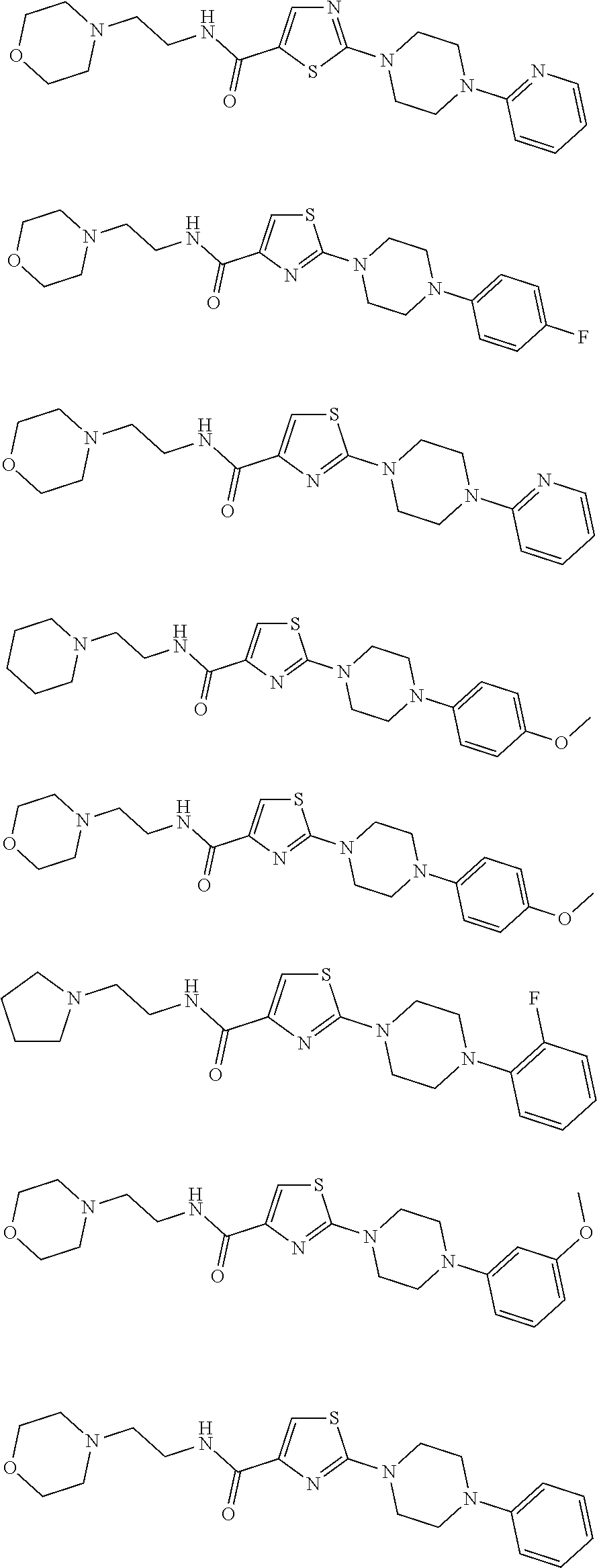Bis-heteroaryl derivatives as modulators of protein aggregation
a technology of heteroaryl derivatives and protein aggregation, applied in the field of bisheteroaryl derivatives, can solve the problems of reducing the neurotoxic effect of aggregated proteins, interfering with protein transcription, autophagy, pore formation, release and/or propagation,
- Summary
- Abstract
- Description
- Claims
- Application Information
AI Technical Summary
Benefits of technology
Problems solved by technology
Method used
Image
Examples
example 1
indol-3-ylmethyl)pentyl]-2-(4-pyrimidin-5-ylpiperazin-1-yl)thiazole-5-carboxamide
[0148]
Step-1: Synthesis of 5-(piperazin-1-yl)pyrimidine hydrochloride
[0149]To a solution of 5-bromopyrimidine (1.00 g, 6.30 mmol) in toluene (20 mL) was added tert-butyl piperazine-1-carboxylate (1.17 g, 6.30 mmol) followed by addition of tBuONa (0.81 g, 8.50 mmol). The reaction mixture was purged with argon for 20 min. Pd(t-Bu3P)2 (0.32 g, 0.62 mmol) was added and the reaction mixture was purged with argon for 10 min. The reaction mixture was heated at 100° C. for 16 h. Progress of the reaction was monitored by TLC and LCMS. After completion, the reaction mixture was concentrated in vacuo. The crude mixture obtained was purified by column chromatography (silica, 100-200 mesh, 5 to 25% EtOAc in hexanes). The product was dissolved in 4 M dioxane HCl (10 mL) at 0° C. and stirred at room temperature for 3 h. The reaction mixture was filtered, washed with cold dioxane (5 mL), dried in vacuo to afford 5-(pip...
example 2
indol-3-ylmethyl)pentyl]-2-(4-pyrimidin-2-ylpiperazin-1-yl)thiazole-5-carboxamide
[0155]
[0156]To a solution of 2-bromo-N-[1-(1H-indol-3-ylmethyl)pentyl]thiazole-5-carboxamide (0.15 g, 0.36 mmol) and 2-piperazin-1-ylpyrimidine (0.09 g, 0.55 mmol) in CH3CN (5 mL) was added K2CO3 (0.15 g, 1.10 mmol) and reaction mixture was heated in sealed tube at 100° C. for 16 h. Progress of the reaction was monitored by TLC and LCMS. After completion, the reaction mixture was concentrated in vacuo. The residue was diluted with H2O (10 mL) and extracted with 10% MeOH in DCM (3×10 mL). The organic layer was separated, dried over anhydrous Na2SO4 and concentrated in vacuo. The crude residue obtained was purified by column chromatography (silica 230-400 mesh, 0.5 to 4% MeOH in DCM) to afford N-[1-(1H-indol-3-ylmethyl)pentyl]-2-(4-pyrimidin-2-ylpiperazin-1-yl)thiazole-5-carboxamide (0.13 g, 72%) as an off-white solid.
[0157]HPLC Purity: 96.2%
[0158]MS (ESI) m / e [M+H]+ / Rt / %: 490.00 / 2.91 / 99.2%
[0159]1H NMR (4...
example 5
indol-3-ylmethyl)pentyl]-2-[4-(2-pyridyl)piperazin-1-yl]thiazole-5-carboxamide
[0170]
[0171]To a solution of 2-bromo-N-[1-(1H-indol-3-ylmethyl)pentyl]thiazole-5-carboxamide (0.15 g, 0.36 mmol) and 1-(2-pyridyl)piperazine (0.07 g, 0.46 mmol) in CH3CN (5 mL) was added K2CO3 (0.15 g, 1.10 mmol) and reaction mixture was heated in sealed tube at 100° C. for 16 h. Progress of the reaction was monitored by TLC and LCMS. After completion, the reaction mixture was concentrated in vacuo. The residue was diluted with H2O (10 mL) and extracted with 10% MeOH in DCM (3×5 mL). The organic layer was separated, dried over anhydrous Na2SO4 and concentrated in vacuo. The crude obtained was purified by column chromatography (silica 230-400 mesh, 0.1 to 1.9% MeOH in DCM) to afford N-[1-(1H-indol-3-ylmethyl)pentyl]-2-[4-(2-pyridyl)piperazin-1-yl]thiazole-5-carboxamide (0.11 g, 61%) as off-white solid.
[0172]HPLC Purity: 95.3%
[0173]MS (ESI) m / e [M+H]+ / Rt / %: 489.00 / 3.01 / 97.1%
[0174]1H NMR (400 MHz, DMSO-d6) δ ...
PUM
| Property | Measurement | Unit |
|---|---|---|
| Mass | aaaaa | aaaaa |
| Time | aaaaa | aaaaa |
| Time | aaaaa | aaaaa |
Abstract
Description
Claims
Application Information
 Login to View More
Login to View More - R&D
- Intellectual Property
- Life Sciences
- Materials
- Tech Scout
- Unparalleled Data Quality
- Higher Quality Content
- 60% Fewer Hallucinations
Browse by: Latest US Patents, China's latest patents, Technical Efficacy Thesaurus, Application Domain, Technology Topic, Popular Technical Reports.
© 2025 PatSnap. All rights reserved.Legal|Privacy policy|Modern Slavery Act Transparency Statement|Sitemap|About US| Contact US: help@patsnap.com



